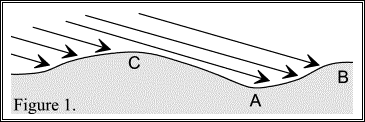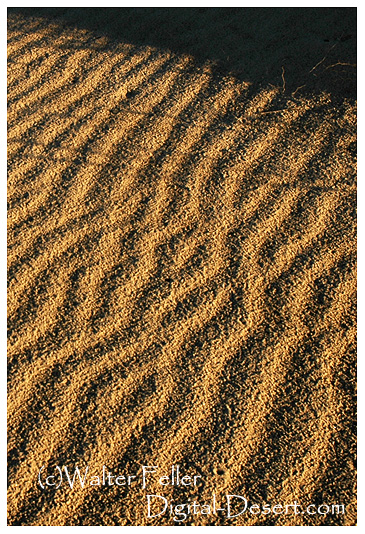Small-scale Sand Accumulation Features
Once sand grains have accumulated into relatively large sandy patches, small-scale geomorphic features will often result, of which surface rippling is the most common. Rippling tends to develop on sandy surfaces that are in a state of relative equilibrium or slow deposition. Surfaces experiencing either marked erosion or vigorous deposition generally do not display rippling (Sharp, 1963).Even an apparently completely flat sand sheet is inherently unstable. Due to variations in grain size a small but significant surface roughness exists, allowing for wind to pick particles. Because larger grains saltate more slowly than smaller grains, they tend to accumulate into "jams", creating more surface roughness. Also, chance unevenness on the sand surface will always be present (Sharp, 1963).
Any unevenness, either random or saltation-induced, will tend to perpetuate itself due to the sensitivity of saltating sand to slight variations in the angle at which grains impact the surface (angle of incidence). What Bagnold refers to as the "characteristic flight path" of saltating sand grains is normally at a very low angle. Since, in most natural sand surfaces, one grain size predominates with a normal distribution around the peak size, saltating sand grains are striking the surface at a relatively uniform angle (approximately ten degrees for the average grain).
When surface unevenness occurs and a small hollow is created, less saltation impacts will occur on the upwind side of the hollow than on the downwind slope (Figure 1). As a result, surface creep along slope AB is considerably greater than creep along slope CA, as slope CA resides in a "saltation shadow." Consequently, sand is removed from point A and deposited at point B, creating a ripple. This, in turn, produces a second hollow downwind of the newly-created ripple and the process repeats itself with numerous parallel ridges forming at right angles to the wind direction. The coarser sand grains will tend to collect at the crest of the ripples since they are not moved as easily by the wind and there is little surface creep down the lee side of the ripples (Bagnold,1941; Sharp, 1963).
As a rule, the "wavelength" of the ripples (the distance between crests of successive ripples) increases with increasing wind speed and reflects the increasing height of ripples and the resultant lengthening saltation shadow (Sharp, 1963). In extremely heavy winds, however, ripples flatten out completely because all grain sizes are easily moved by the wind and the differential saltation and creep rates needed for ripple formation decline (Bagnold, 1941; Sharp, 1963).
The height of an individual ripple is a function of grain sorting. The more uniform the sand surface the shallower the ripples, because of the reduced amount of differential saltation and surface creep. Due to the interference of wind speeds by the growing ripples, a maximum height limit exists. As ripples increase in height, they move into levels of higher wind speeds, causing heavier grains to be blown from the ripple crests and into the troughs, filling them in (Cooke and Warren, 1973). Bagnold (1941) claims that the ripple height is generally no more than one-tenth the wavelength of the ripples. In the Kelso dune filed, Sharp (1963) found a maximum wavelength of nineteen centimeters and a maximum height of one centimeter, with an average wavelength/height ratio of 18. However, Sharp notes that no satisfactory universal qualification of this height-wavelength relationship has been obtained.
In his studies of the Kelso dunes, Sharp (1963;1966) also found that ripples move downwind at relatively fast rates. At a threshold velocity of 18 kph, ripples advanced downwind at a rate of .9cm per minute, with the rate increasing to 8 cm per minute during the strongest winds. Consequently, Sharp concluded the "adjustment in size, shape and spacing can presumably occur rapidly in response to differences in velocity" (1963, p. 631). From an initially flat surface, ripples can form a complete pattern in ten minutes (in a 48 kph wind) and can flatten out, reform or change direction as quickly. This rapid formation and movement of sand ripples also contributes to a large volume of sand movement. At one test plot, Sharp discovered that, in one hour's time, 48 kph winds could move 6000 pounds of sand across a 32-meter line.
In areas where the sand surface has a relatively large number of coarse sand grains (greater than 1 mm in diameter) , a second type of small-scale feature occurs, called a "ridge" by Ragnold and a "granule ripple" by Sharp. Granule ripples generally form in sands with a bimodal distribution of grain size - one fine and one coarse - where winds are moderate-to-strong but not strong enough to pick up coarser grains (Bagnold, 1941; Sharp, 1963).
Bagnold claimed that, like ripples, granule ripples resulted from finer saltating grains pushing coarser grains (via surface creep) into jams. Unlike sand rippling, however, these concentrated ripples of coarser grains are rarely, if ever, moved by direct wind pressure. Consequently, they are more stable and can grow to larger dimensions than sand ripples. As more and more coarse grains arrive from upwind, the granule ripple can grow quite high and the resultant saltation shadow prevents movement of large grains from the crest into the leeside trough. In contrast to sand ripples, growth and movement of granule ripples is very slow, and individual granule ripples can exist for decades and even centuries, allowing for much greater heights and wavelengths than can develop on ephemeral sand ripples (Bagnold, 1941).
Sharp (1963) tested Bagnold's theories in the Kelso dune field. Sharp found that granule ripples were generally located in deflation hollows between dunes, where winds had removed the finer material and produced a coarse-grained surface. The granule ripples at Kelso dune field were more irregular than the sand ripples, often forming wavy chains resembling miniature barchanoid ridges. As Bagnold predicted, Sharp found that granule ripples indeed adjusted very slowly to changing wind velocities and directions. Sharp found granule ripples that were at least several months old and measured up to 12.5 cms high and over two meters in wavelength. (Bagnold reported granule ripples in Africa sixty centimeters in height and six meters in wavelength.) Sharp also states that he found no gradations between sand ripples and granule ripples; rather, he found them to be distinct features even when occurring side by side, "with a sharp line of demarcation" (1963, p. 632).
Large-scale Sand Accumulation Features

 Kelso Dunes
Kelso Dunes